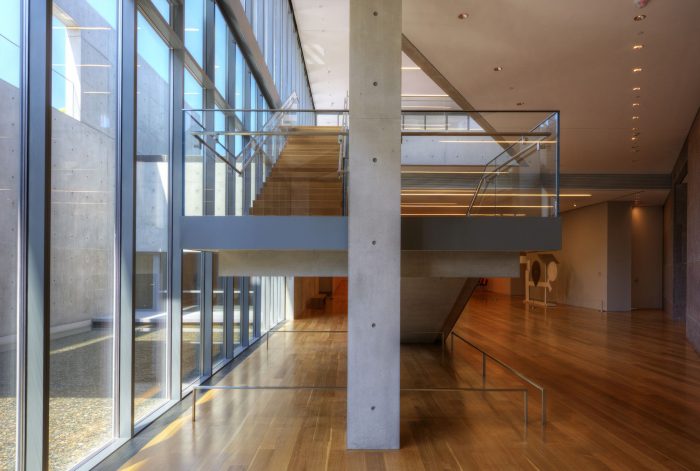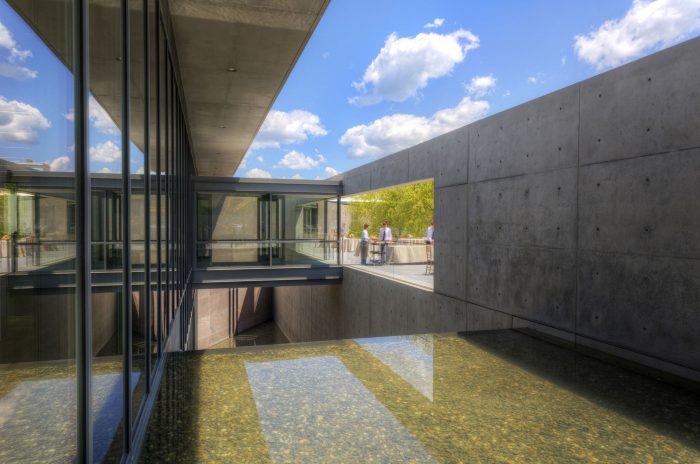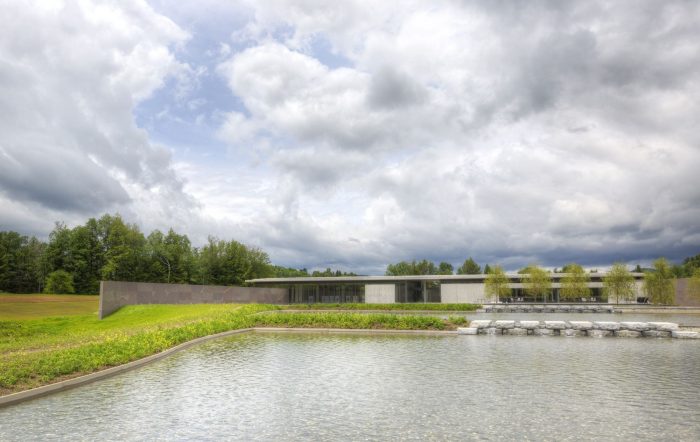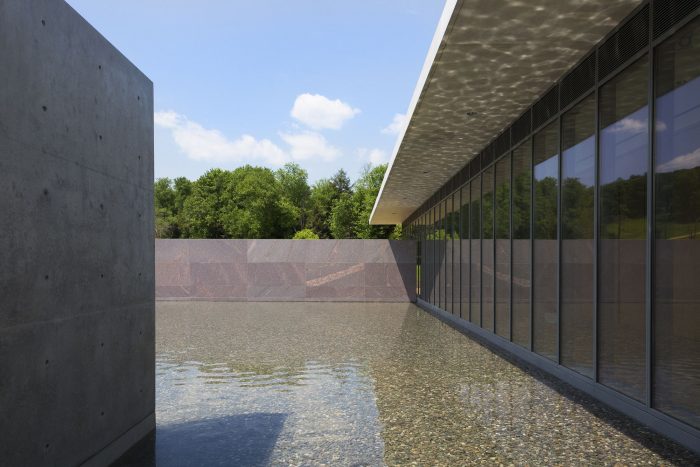Clark Art Institute Tadao Ando Architect Associates
The Clark Art Institute is in its terminal phase of a transformational campus expansion program that adds new facilities to support the growth of the museum and bookish programs, enhances the company experience, improves apportionment throughout the campus, and creates new levels of sustainability across its 140 acres. The plan focuses on providing superior facilities for the do good of visitors and scholars and underscores Clark's environmental stewardship of its grounds.
 The project was initiated in 2001 after the cosmos of a master programme by Cooper, Robertson & Partners that reconceived the campus. Accomplished through a phased approach, the projection includes:
The project was initiated in 2001 after the cosmos of a master programme by Cooper, Robertson & Partners that reconceived the campus. Accomplished through a phased approach, the projection includes:
– construction of the Lunder Center at Stone Loma (completed in 2008)
– construction of the new Clark Center
– renovation of the Museum Building and expansion of galleries
– the ongoing renovation of the Manton Research Heart
– redesign and reconfiguration of the Clark's grounds
– demolition of an existing concrete establish building
– construction of new below-class concrete establish facilities (completed in 2012)
– comprehensive site piece of work package
– installation of more than two miles of walking trails
 Landscape.
Landscape.

photography by © Tucker Bair
The Clark's entire 140-acre campus is renewed and enhanced by the introduction of 4 miles of new walking trails, five new pedestrian bridges, and more than a thousand new copse. But the focal indicate of the landscape is a set of tiered reflecting pools.
Reed Hilderbrand Landscape Architecture designed the pools, with their cascades, lawn embankments, and stepping stones to knit together the architectural refinement of the inner campus with the pastoral sweep of Stone Hill Meadow and the meander of Christmas Brook and its wetlands. In guild to run across the environmental and experiential goals of the Clark and the community, the pools needed to fit into the site'due south topography, hydrology, and habitat.
Conceived by architect Tadao Ando as a unifying element for the campus and its surroundings, the pools orchestrate a unified composition amid the diverse architectural characters of the Clark Center, the Museum Building, the Manton Enquiry Center, and the varied mural across. The Clark Eye terraces overlook the uppermost pool, which reflects views of wetlands and woodland beyond every bit visitors get in.

photography by © Tucker Bair
 The entirety of the pools links the cultivated lawns of the central campus with the pastures of the Rock Hill meadow and the intricate network of streams that define the site's drainage systems and shape its habitat. Backyard walks and embankments thread between the pools. H2o cascades through granite weirs from i pool to the next and then is recycled through a system that integrates rainfall capture, stormwater management, mural irrigation, and building systems, including climate control and toilet flushing.
The entirety of the pools links the cultivated lawns of the central campus with the pastures of the Rock Hill meadow and the intricate network of streams that define the site's drainage systems and shape its habitat. Backyard walks and embankments thread between the pools. H2o cascades through granite weirs from i pool to the next and then is recycled through a system that integrates rainfall capture, stormwater management, mural irrigation, and building systems, including climate control and toilet flushing.
Key Landscape Features
– Operational volume for reflecting pools is 284,000 gallons of water over an area of 42,000 square anxiety (approximately 1 acre) at an average depth of 13 inches
– 2000 gallons of h2o menses through the pools each minute
– Schow Swimming surface area enhanced and views from galleries improved
– 500 copse added in the final stage; 1150 new trees planted overall
– Upgrades and extensions to 4 miles of walking trails, including 5 pedestrian bridges
– Landscaped parking for 398, including 154 overflow meadow spaces and 69 porous asphalt spaces
– Invasive plant species removed
– 1.5 miles of new drives built since 2005
– 80 acres of the campus maintained as woodland
– 49 acres of the campus managed as native meadow
– 15 acres of the campus protected as wetland and waterway
– ten meadow rain gardens capture and care for runoff
 Sustainability
Sustainability

photography past © Tucker Bair
The water direction organisation designed for the Clark, prominently represented past the tiered pools, was conceived to reduce total h2o consumption for the expanded campus through the interconnection of mural and building h2o sources. This system transforms what would have been considered wastewater into a resource; balances the demand to rebuild groundwater through infiltration on site with the desire to get-go potable water use in the building; and improves the health and functioning of surrounding wetlands and streams through careful mitigation of storm events and runoff.
Original modeling of total water savings, based on a first design study, forecast no potable water consumption in the landscape. As-built performance modeling is forthcoming. The Clark has too elected to commission the entire landscape, equally 1 does for building mechanical systems, to raise and evaluate the performance of all of its landscape features and assets and to provide a model for hereafter projects.
Through intense collaboration, the blueprint squad created an integrated hydrological system that links all of the campus buildings to the reflecting pool and landscape. Using diverse harvesting techniques (drains, pipes) and storage techniques (reservoirs, tanks), the organisation collects foundation h2o, also every bit rainwater, and funnels it into the reflecting pool. The collected water is also used for irrigation, plumbing (greyness water for the toilets), and for makeup water for the cooling tower.
 – Downstream belch is biologically cleansed in the lowest of the puddle'due south three tiers and its synthetic wetlands, assuring that no contaminants enter the brook that flows across the lower campus.
– Downstream belch is biologically cleansed in the lowest of the puddle'due south three tiers and its synthetic wetlands, assuring that no contaminants enter the brook that flows across the lower campus.
– A series of vii geothermal wells installed on the campus reduces Clark's consumption of electricity and heating resources by 28 percent.

photography past © Tucker Bair
– The puddle also connects to cisterns fed by rooftop collection basins that capture rainwater for use in the campus'southward cooling tower and reservoir and utilizes that nonpotable greywater for plumbing and irrigation.
– The campus will employ one million fewer gallons of water annually than it did before the Clark Middle and reflecting puddle was constructed. Rather than doubling the pre-development water usage, the projection is designed to achieve a l percent reduction.
– Dark-green roofs, dimmable lighting systems, and the vii geothermal wells installed on the campus are just iii of the energy-saving strategies that reduce Clark'south energy utilisation by 20 percent.
– The design team also elected to apply recycled content materials including fly-ash (structural concrete) and silica (architectural physical), as well as 10 percent recycled steel throughout the project. Thirty percent of all building materials were locally sourced.
– Sustainable site strategies include reducing impervious surfaces (and minimizing traditional parking surfaces) and harvesting stormwater for alternative site use (the reflecting pool and irrigation) to reduce the site's environmental impact.
– The Clark Center aims to achieve LEED – New Construction Silver Certification from the Us Edifice Quango (USGBC).

photography past © Tucker Bair
 Project Info:
Project Info:
Architects: Gensler, Reed Hilderbrand Mural Architecture, Selldorf Architects, Tadao Ando Architect & Associates
Location: 225 South Street, Williamstown, MA 01267, The states
Expanse: 97700.0 ft2
Projection Year: 2014
Photographs: Jeff Goldberg – ESTO, Tucker Bair, Nicholas Whitman, Mike Agee, Betty Sartori, Kris Qua, Jonas Dovydenas, Reed Hilderbrand
Manufacturers: Pyrok
Project Name:Clark Art Institute
Source: https://www.arch2o.com/clark-art-institute-selldorf-architects-gensler-tadao-ando-architect-associates-reed-hilderbrand-landscape-architecture/
0 Response to "Clark Art Institute Tadao Ando Architect Associates"
แสดงความคิดเห็น